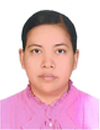Thanda Thatoenwewin
In 2000, I graduated My Bachelor Degree (B.E (Civil)) from Yangon Institute of Technology, Myanmar. In 2004, I got my Master of Engineering M.E (Civil), from Yangon Institute of Technology, Myanmar. I do the research on the River Training Near Bo Myat Htun Bridge.
In 2008, I got my Master of Engineering M.E ( Civil and Environmental Engineering) from Saitama University, Japan. My research was the deformation behaviour of Shirahama Sandstone in the moisture transfer process.
I started my PhD in the water resources department from 24, July, 2014. My research is “Assessment and monitoring of the water quality of the Ayeyarwady River in Myanmar”. The Ayeyarwady River, the main river in Myanmar, is located in Southeast Asia. The Ayeyarwady river flows through the centre of the country and discharges into the Bay of Bengal and Andaman Sea through nine river mouths. Its total drainage area is about 411000 km2 , covering 61 % of country’s total area. At approximately 2170 km long, it is Myanmar’s most important commercial waterway and 26 million people are living in the basin area. With the increase of population and enhanced need for water for economic activities, there is increasing pressure on use of surface water and extraction of ground water. Control and management of surface water and groundwater is therefore important for sustainable development of the country. Most of the anthropogenic activities are unplanned and haphazard and therefore, such activities have been identified as one of the major crucial issues which leads to the rapid deterioration and degradation of water ecosystem and its biodiversity. The use of chemical fertilizer in the agriculture, the mining activities in the catchment area, wastewater effluents from the industries and communities and other development activities generate large quantities of pollutants of different nature. Adverse impacts of these pollutants not only harm the water environment, but also affect the socioeconomic benefits and public health of the communities. In Myanmar, there are many government organizations related to water quality management. Each water user organization monitors water quality for their own purposes. The monitoring is haphazard, short term and based on individual interest and the reagents and the equipment available. The monitoring is not properly coordinated and quality assurance programme is not incorporated in most of the studies. Therefore, comprehensive data on the water quality of rivers in the Myanmar is not available. In this 4 years study, the current status of the water quality of the Ayeyarwady river will be found out based on the available water quality data. Furthermore, the water quality situation of other rivers in the South East Asia Countries will be studied comparatively. Finally, a network for water quality monitoring for the Ayeyarwady river will be designed based on state-of-the art scientific knowledge.

Thanda Thatoenwewin
- +31 644147185
- T.T.N.W.ThandaThatoeNweWin@tudelft.nl
-
Room number: Civil Engineering, 4.91